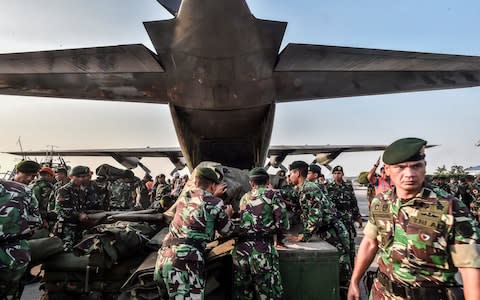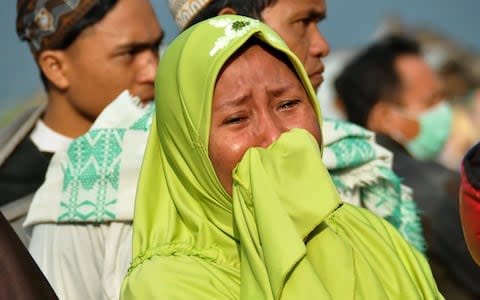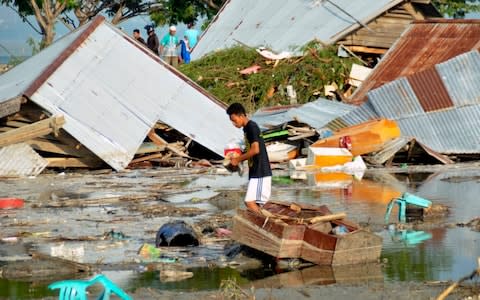Indonesia tsunami: Thousands feared dead after 10-foot-high waves slam into two cities on Sulawesi

The death toll from a devastating 7.5 magnitude earthquake and tsunami that struck the Indonesian island of Sulawesi on Friday could rise to thousands, the country’s national disaster agency has warned.
More than 400 people were confirmed dead in the city of Palu, where preparations for a beach festival had been underway as a towering wave of at least ten feet high barreled into the coastline.
The terrifying moment was captured on a smartphone video that showed the wave crashing over and submerging one-storey buildings and cars by the beach as bystanders screamed and ran for cover.
The casualty count “would be hundreds, if not thousands,” Sutopo Purwo Nugroho, a spokesman for the disaster agency told The Telegraph.
“Almost all the houses by the beach, shops, a hospital, hotels, have all fallen down. During the weekend they are all full of visitors,” he said.
The Head of the National Disaster Management Agency (BNPB), Willem Rampangilei, told reporters in Sulawesi late on Saturday the death toll from Palu had reached 420 people, according to news website Kompas.
"It's estimated that 10,000 refugees are scattered in 50 points in Palu city," he was quoted by Kompas as saying. "We are having difficulty deploying heavy equipment to find victims under the rubble of buildings because many of the roads leading to Palu city are damaged."
Amateur video footage showed trees, buildings and a communications tower being swept through a rural landscape. The landslide was caused by liquification of the soil, according BNPB's Nugroho.
In a terrible twist of fate, an estimated 1,000 people, many of whom remain unaccounted for, had arrived to attend a cultural festival, which was due to be inaugurated on the beachfront by the tourism minister.
“About 250 local security personnel were on standby..and the beach was already full with festival-goers when the earthquake struck. People tried to run away from the beach, but not so many survived. They were caught by the water,” said Mr Sutopo.
Sulawesi was hit by several earthquakes on Friday, including one of a 6.1 magnitude earlier in the day.
According to the US Geological Survey, the strongest of 7.5 struck at a depth of 10km, 56km northeast of the coastal town of Donggala. Initial reports suggest it triggered an underwater avalanche that caused the tsunami.
The Red Cross said staff and volunteers were heading to the affected areas.
"We're now getting limited communications about the destruction in Palu city, but we have heard nothing from Donggala and this is extremely worrying. There are more than 300,000 people living there," Red Cross said in a statement.
"This is already a tragedy, but it could get much worse."
With desperation rising on Sunday, looters were stealing items from a badly damaged shopping mall.
People were clambering over wreckage to reach goods while people were reportedly still trapped inside.
Local TV showing goods being thrown out of collapsed department store in Palu. People clambering over wreckage to get it. Dozens still trapped inside. pic.twitter.com/Kx02ySXzCb
— David Lipson (@davidlipson) September 30, 2018
One eyewitness called Adam told the Kompas.com website that people had panicked and tried to flee after the first earthquake hit.
“After that, we saw water suddenly crashing, and finally there was a big panic. Not having time to escape, there was a bigger earthquake, and suddenly the water rose," he said.
Shocking images of destruction in Palu emerged quickly on social media, showing split roads, collapsed homes, mosques and supermarkets which had been crowded with shoppers before disaster struck.
The most tragic pictures revealed partially covered bodies, and the silhouette of a man carrying a dead child through the wreckage. Hundreds of injured are being treated outside and in makeshift tents in field hospitals.
But with communications and electricity down in much of Sulawesi, the full extent of the damage and loss of human lives remains unclear. Rescuers are still struggling to get to the stricken area, and have not yet been able to reach the worst-hit towns, including Donggala.
The military is deploying troops to both Palu and Donggala but rescue efforts have been hampered by severe damage to the control tower and runway at Palu airport.
In an act of selfless heroism, Anthonius Gunawan Agung, 21, an air traffic controller, lost his life after refusing to leave the shaking tower because he was guiding an aircraft during take-off.

As his colleagues ran out of the building Mr Agung calmly remained at his station to ensure the plane left safely.
According to Mr Sutopo, his last words were “Safe flight Batik Air, take care” as the plane soared into the sky, its passengers and crew unaware that they had narrowly escaped a major earthquake.
Mr Agung died on Saturday from injuries sustained after jumping from the four-storey tower as it collapsed.
Speaking afterwards to the local media, Captain Ricosetta Mafella, said he had been initially confused by the bumpy take-off as plane was shaking left and right, but he had assumed it was the result of an uneven runway.
“I was focussing on getting airborne, so I didn’t pay too much attention to the ground,” he said. As he ascended, Mr Mafella tried to contact air traffic control and was perplexed to receive no answer from Mr Agung.
From the air, he noticed unusual waves rolling into Palu, but it was only later that he discovered he had made a dramatic take-off at the start of an earthquake.

Palu's airport halted operations for 24 hours due to earthquake damage, according to AirNav, which oversees airline traffic in Indonesia.
Mirza Arisam, a resident of Kendari, the capital of neighboring Southeast Sulawesi, said his uncle and his family of five, including three children, were on holiday in Palu and he has been unable to contact them since the tsunami hit.
In Palu's Roa-Roa Hotel, which was completely flattened by the quake, many people were still missing.
"Communication is cut off. All we knew is that 24 guests were successfully evacuated and one has died," hotel owner Ko Jefry told Metro TV on Saturday night. "It is estimated that 50 to 60 people remain trapped."
Mr Nugroho tweeted a video the rescue and recovery effort being conducted there on Sunday.
Evakuasi korban tertimbun gempa di Hotel Roa-Roa Kota Pqluterus dilakukan Tim SAR Gabungan dikoordinir Basarnas. Diperkiran terdapat 50 orang di bawah reruntuhan bangunan. Alat berat diperlukan untuk evakuasi. pic.twitter.com/LGWwp3OEhE
— Sutopo Purwo Nugroho (@Sutopo_PN) September 30, 2018
After the quake struck, television footage showed people running into the streets. Women and children wailed hysterically in a video distributed by the disaster agency, which also released a photo showing a heavily damaged department store.

"It was so strong. The strongest I ever felt. We all ran out of buildings," said Yanti, a 40-year-old housewife in Donggala who goes by a single name.
"All the things in my house were swaying," another Donggala resident, Mohammad Fikri, said of the earlier 6.1 quake.
UN spokesman Stephane Dujarric said U.N. officials were in contact with Indonesian authorities and "stand ready to provide support as required."
Rolex Mahala, Chief Correspondent of Antara Newswire in Palu, described the aftermath of the earthquake as terrifyingly chaotic.
“I heard people shouting: “Go to higher ground... go to higher ground. Don’t stay, there might be a tsunami!”

“My family and I fled up a hill in the dark. I stumbled a lot, my grandchildren were crying, but we kept walking. I later tried to get them to sleep, while I kept watch in the middle of the night,” said Mr Rolex.
Major Edy Harahap, the Deputy Commander of Military District Command in Palu was assigned to help the rescue effort at Talise Beach, where the cultural festival was taking place.
But the area was difficult to access because of debris from wrecked buildings and bodies. While he was formulating a plan, he heard a voice calling out to him: “Commander, help me, help me!”
A young boy of about ten years old was crying to him from the roof of a hut. The child told him he had been playing on the beach with his friends when the tsunami approached.
“Suddenly a big wave came in our direction. So I ran away, but I was thrown onto that roof. I tried to shout for help, but there was no one yesterday. I tried to call my friends too, but no one answered me,” the boy said.
The officer fears that many street vendors, attracted by the festival, would have been swept out to sea, as well as children, especially girls, who had come to perform dances.
President Joko Widodo is scheduled to visit evacuation centres in Palu on Sunday.
Jembatan Palu IV destroyed by the earthquake in #Palu, Central Sulawesi.#gempa#tsunamipic.twitter.com/Q8PKwvE5Hj
— Matthew Lanier (@PakMamat) September 28, 2018
Indonesia is prone to earthquakes because of its location on the "Ring of Fire," an arc of volcanoes and fault lines in the Pacific Basin.
In December 2004, a massive magnitude 9.1 earthquake off Sumatra in western Indonesia triggered a tsunami that killed 230,000 people in a dozen countries.

